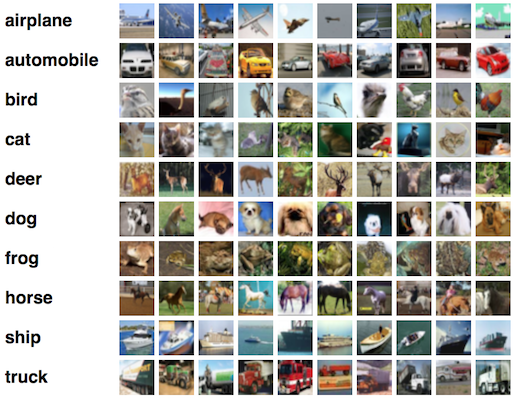About the CIFAR-10 dataset¶
CIFAR-10 (classification of small images across 10 distinct classes---airplane, automobile, bird, cat, deer, dog, frog, horse, ship & truck).

The CIFAR-10 dataset contains 50000 training examples and 10000 test examples. Each example is a $32 \times 32 pixels coloured image.
Loading and pre-processing CIFAR-10 dataset¶
In [ ]:
%matplotlib inline
import matplotlib.pyplot as plt
import itertools
from keras.datasets import cifar10 # subroutines for fetching the CIFAR-10 dataset
from keras.utils import np_utils # utilities for one-hot encoding of ground truth values
import numpy as np
from sklearn.utils import shuffle
from skimage import feature
(X_train_img, y_train), (X_test_img, y_test) = cifar10.load_data() # fetch CIFAR-10 data # dirname="."??
y_train = y_train.ravel()
y_test = y_test.ravel()
print(X_train_img.shape)
print(X_test_img.shape)
class_names = ['plane', 'car', 'bird', 'cat', 'deer', 'dog', 'frog', 'horse', 'ship', 'truck']
# Shuffle examples
X_train_img, y_train = shuffle(X_train_img, y_train)
X_test_img, y_test = shuffle(X_test_img, y_test)
plt.figure()
plt.imshow(X_train_img[0])
plt.show()
print(class_names[y_train[0]])
plt.figure()
plt.imshow(X_train_img[1])
plt.show()
print(class_names[y_train[1]])
plt.figure()
plt.imshow(X_train_img[2])
plt.show()
print(class_names[y_train[2]])
num_train, depth, height, width = X_train_img.shape # there are 50000 training examples in CIFAR-10
num_test = X_test_img.shape[0] # there are 10000 test examples in CIFAR-10
num_classes = np.unique(y_train).shape[0] # there are 10 image classes
Y_train = np_utils.to_categorical(y_train, num_classes) # One-hot encode the labels
Y_test = np_utils.to_categorical(y_test, num_classes) # One-hot encode the labels
# Produce a [0;1] normalized "image" for potential input into a convNet
X_train_img_norm = X_train_img.astype('float32')
X_test_img_norm = X_test_img.astype('float32')
X_train_img_norm /= np.max(X_train_img_norm) # Normalise data to [0, 1] range
X_test_img_norm /= np.max(X_train_img_norm) # Normalise data to [0, 1] range
# Rasterize normalized images into 1D vectors for potential input of raw image into standard ML algo such as kNN, MLP, SVM, etc
X_train_vectNorm = X_train_img_norm.reshape(num_train,height*width*depth)
X_test_vectNorm = X_test_img_norm.reshape(num_test,height*width*depth)
print(X_train_vectNorm.shape)
print(X_test_vectNorm.shape)
print(X_train_vectNorm[1:5])
# Compute HOG feature as potential BETTER input into standard ML algo such as kNN, MLP, SVM, etc
#
#hog, hog_image = skimage.feature.hog(img, orientations=9, pixels_per_cell=(8, 8),
# cells_per_block=(3, 3), block_norm=None,
# visualise=True, transform_sqrt=False, feature_vector=True)
# TO BE CORRECTED/FINALIZED!...
Une fonction pour afficher graphiquement les matrices de confusion¶
In [ ]:
%matplotlib inline
import matplotlib.pyplot as plt
import itertools
# Definition for the function that plot the confusion matrix
# See : http://www.sci-kit.org/
def plot_confusion_matrix(cm, classes,
normalize=False,
title='Confusion matrix',
cmap=plt.cm.Blues):
"""
This function prints and plots the confusion matrix.
Normalization can be applied by setting `normalize=True`.
"""
plt.imshow(cm, interpolation='nearest', cmap=cmap)
plt.title(title)
plt.colorbar()
tick_marks = np.arange(len(classes))
plt.xticks(tick_marks, classes, rotation=45)
plt.yticks(tick_marks, classes)
if normalize:
cm = cm.astype('float') / cm.sum(axis=1)[:, np.newaxis]
print("Normalized confusion matrix")
else:
print('Confusion matrix, without normalization')
print(cm)
thresh = cm.max() / 2.
for i, j in itertools.product(range(cm.shape[0]), range(cm.shape[1])):
plt.text(j, i, cm[i, j],
horizontalalignment="center",
color="white" if cm[i, j] > thresh else "black")
plt.tight_layout()
plt.ylabel('True label')
plt.xlabel('Predicted label')
Baseline method: kNN on raw normalized pixels¶
In [ ]:
from sklearn import neighbors
from sklearn.metrics import confusion_matrix
clf = neighbors.KNeighborsClassifier(n_neighbors=5)
clf.fit(X_train_vectNorm, y_train)
y_test_pred_knn = clf.predict(X_test_vectNorm)
cnf_matrix_knn = confusion_matrix(y_test, y_test_pred_knn)
print(cnf_matrix_knn)
np.set_printoptions(precision=2)
plt.figure()
class_names = ['plane', 'car', 'bird', 'cat', 'deer', 'dog', 'frog', 'horse', 'ship', 'truck']
plot_confusion_matrix(cnf_matrix_knn, classes=class_names, normalize=True, title='Normalized confusion matrix')
plt.show()
In [ ]: